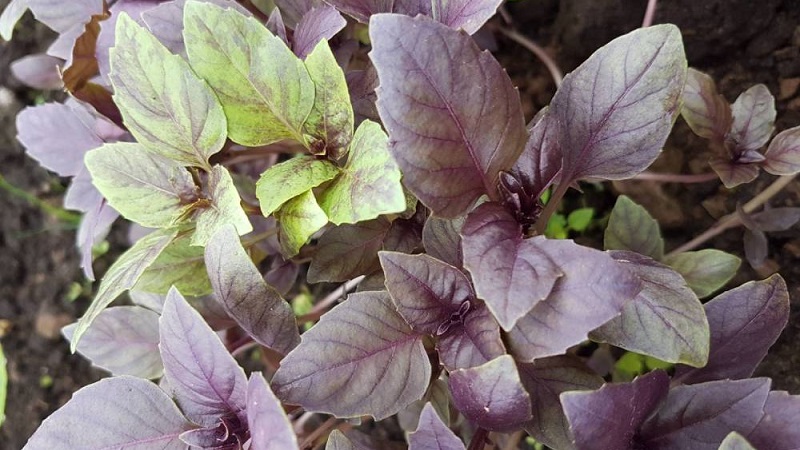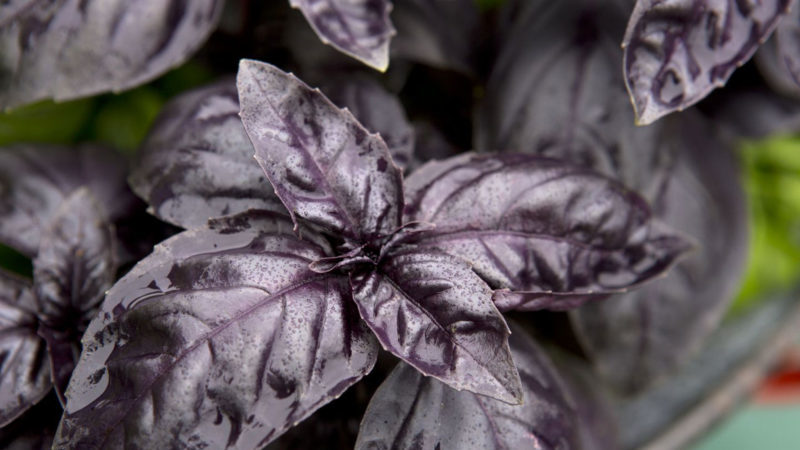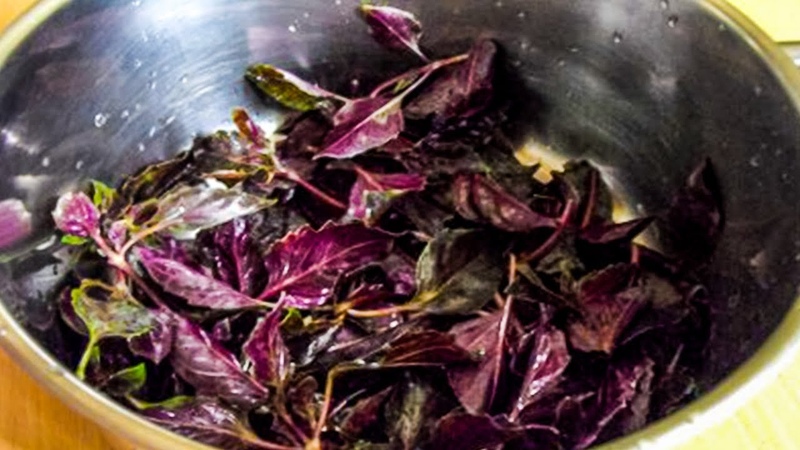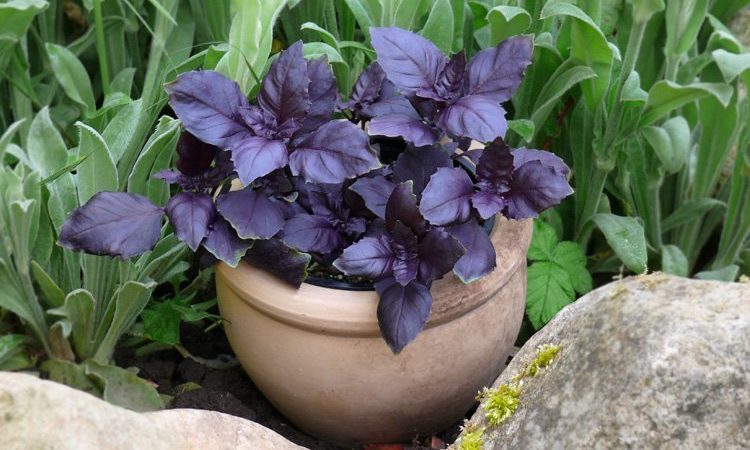Purple basil - benefits and harms
Purple or red basil is gaining popularity. Having much in common with the green representative of the family, species with a dark color are distinguished by a number of features in terms of external characteristics, aromatic qualities, taste characteristics, and also amaze with an abundance of varieties and benefit our health.
From the article, you will learn how basil differs from regan, what purple varieties exist and what are the benefits and harms of the plant for health.
The content of the article
Another name for the basilica

The popular spice spread throughout the world is called differently:
- ocimum - official designation in Latin;
- royal herb - this name is found in the literature - it is a direct translation of the word basileus ("king", "king");
- popular names reflect its inherent rich smell: fragrant cornflower, scent, dusky;
- the ancient Greek name for the herb is okimon;
- Eastern names that sound similar to each other: Reikhan, Rean, Regan, Raykhon - all this is basil.
Each of the names refers to all plants of the genus, regardless of color, species or varieties... The most common of these are basil and regan.
Purple or red basil: species description
Regan, like mint, belongs to the Lamiaceae family. Common features of species with dark colored leaves and stems are peppery flavor and sharper aroma due to the high content of essential oils.
Basil of purple and red flowers is used not only for food or for treatment, but also as an ornamental plant that adorns parks and backyards.
Depending on the variety:
- annuals and perennials, propagated by seeds or seedlings;
- the height of the bushes is from 15 to 70 cm;
- a variety of aromatic and gustatory nuances - shades of pepper, cloves, bay leaves, ginger, mint and even vanilla;
- the color of the stem and leaves ranges from red-green to purple-black, including lilac, purple, brown and combinations thereof;
- flowers - from pale pink to purple;
- leaves are ovoid in shape with fine or coarse toothed edges, from 1 to 6 cm in length;
- the stems are pubescent or smooth; in an adult plant they become stiff.
The stiff branches of the sacred basil (tulasi) are used in rituals in Hinduism, beads and rosary are carved from them.
Health benefits and harms of purple basil
The rich content of rutin and carotene is inherent in any type of regan. But the concentration of essential oils, saponin and eugenol in purple varieties is 1.5-2 times higher than in green ones. The plant is used in folk and official medicine, cosmetic and food industries.
Attention! Basil, along with laurel, wormwood and rosemary, serves as a raw material for obtaining camphor, which is used in medicine and aromatherapy.
Useful and medicinal properties

Regular inclusion of Reikhan in the diet contributes to:
- acceleration of metabolic processes and fat burning;
- strengthening of blood vessels;
- establishing intestinal peristalsis, removing accumulated gases;
- elimination of uric acid, destruction of kidney stones, reduction of pain;
- maintaining and restoring immunity.
Basil infusions:
- help with diseases of the gastrointestinal tract, having an antispasmodic, anti-inflammatory and carminative effect;
- relieve or reduce pain in renal and intestinal colic;
- increase pressure.
Broths are used for:
- healing of internal and external wounds;
- prevention of tooth decay and gum disease;
- strengthening hair roots and improving their structure.
Inhalation of plant essential oils:
- stimulates the work of the cardiovascular system,
- has a calming effect on the nervous system;
- protects against respiratory diseases;
- relieves asthma.
Freshly squeezed juice of the plant relieves inflammation of the middle ear and is used in the treatment of difficult-to-heal wounds.
Basil can reduce the risk of cancer with a holistic approach and proper nutrition. The high iron content of regan in combination with essential oils relieves headaches and stimulates oxygenation of the blood. The beta-carotene present in the herb improves eyesight, nails, hair and skin.
Important! The best time to harvest basil for essential oils is spring, and the maximum accumulation of ascorbic acid coincides with the appearance of peduncles.
Harm and contraindications
Abuse of even the most useful product has the opposite effect. So, taking Reihan in excessive amounts irritates the intestinal mucosa, and essential oils can cause an allergic reaction.
The use of basil preparations is contraindicated in:
- heart disease - ischemia, myocardial infarction, angina pectoris;
- hypertension;
- thrombophlebitis and thrombosis;
- diabetes mellitus;
- epilepsy.
Raw herb can be consumed in small quantities based on how you feel.
Purple basil varieties

In total, the regan has 69 varieties. About a third of them are purple and red species.
Due to the high yield, taste and aroma, more often than others are grown:
- Tulasi (Ocimum sanctum - "sacred basil") - sparsely toothed greenish-lilac ovoid leaves on short petioles, the stem and leaves are covered with hairs. Bright clove-pepper notes prevail, aftertaste - with a slight bitterness. It is ubiquitous in India, where it is used in rituals, used in Ayurvedic medicine and added to spicy dishes.
- Yerevan - early ripening variety, stretches up to 60 cm, blooms in pink and lilac. They are added to food and used to decorate flower beds. Gives 2-3 harvests per season. It is distinguished by the aroma of allspice and tea.
- Black garnet - bred in Egypt. A compact, lush shrub with an intense spicy scent, yields 2-3 harvests per season, provided that the lower pairs of leaves are left during cutting.
- Violet - refers to mid-season varieties. Grows up to 70 cm, leaves with short petioles, ovate, with sparse denticles. The stem and leaves are covered with hairs. Pepper notes predominate.
- Purple - early ripe, up to 30-40 cm in height, spreading with small leaves of violet-green or purple color. The variety has a clove smell.
- Vanilla aroma - a tall plant with succulent leaves that change color from green to purple as it grows. Due to its specific taste, it is used for the production of vanillin.
- Aramis and Red Ruby - two more varieties suitable for the production of confectionery and aromatization of drinks due to the pronounced caramel-fruit aroma. Mid-season, up to 40 cm high.
- Osmin - compact, well-leafy bush up to 30-40 cm high with small finely toothed purple leaves. Has a spicy smell and mild taste. Bred in India.
- Dark opal (African blue basil) is a non-flowering hybrid bred in 1950 in the United States. The plant is red-violet in color with crimson flowers. The taste is dominated by hints of pepper and cloves.
A mixture of crushed rosemary leaves and dark-colored, pepper-flavored regan is used in place of pepper.
The variety of nuances of smells, tastes, shapes and sizes of plants, as well as their ripening rate allows:
- receive harvests from different varieties throughout the season;
- procured for future use in dried and frozen form;
- grow as an ornamental plant in a garden or in an apartment.
It is interesting:
Why is basil tea useful and what are the most delicious recipes for brewing it?
Conclusion
Having met any of the names of basil in cookbooks or recipes of traditional medicine, you no longer have to guess what it is about.
Knowing a little more about the variety and variety of species, it will be easier to choose a plant that meets aesthetic and taste preferences. And spice lovers will surely appreciate the intensity of the tastes and aromas of the purple varieties.